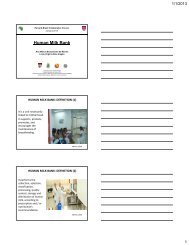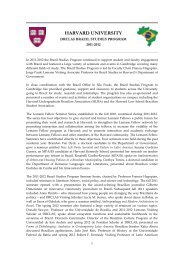Harvard - DRCLAS Brazil Office - David Rockefeller Center for Latin ...
Harvard - DRCLAS Brazil Office - David Rockefeller Center for Latin ...
Harvard - DRCLAS Brazil Office - David Rockefeller Center for Latin ...
You also want an ePaper? Increase the reach of your titles
YUMPU automatically turns print PDFs into web optimized ePapers that Google loves.
Pre-treatment: This includes the pre-oxidation, rapid mix, coagulation and dissolved air flotation<br />
(DAF). These processes with the application of ozone and a coagulant chemical, alum, remove:<br />
manganese, natural color, particles, algae, protozoa, viruses and bacteria from the water.<br />
Intermediate Ozone: In this step fine bubbles of ozone are dissolved into the water and disinfect the<br />
water by killing bacteria, viruses, and protozoa. The ozone in generated in the plant and introduced into<br />
the water in a series of chambers that allow contact and mixing of the ozone with the water. At the end of<br />
this process all the ozone introduced is removed from the water.<br />
Granular Activated Carbon (GAC) Filtration: This step follows the ozone application to help remove<br />
any organic compounds that may have been rendered biologically active or useable by the ozone step.<br />
The filters further polish the water by removing additional particles, color and protozoa from the water.<br />
Chlorination: The chlorination after the filters kills bacteria that may develop during the normal<br />
operation of the filters. The chlorination step also provides a level of redundancy in the overall<br />
disinfection process.<br />
Post Treatment Chemical Addition: This includes the adjustment of pH <strong>for</strong> corrosion control, the<br />
addition of fluoride <strong>for</strong> dental health, and chloramination to provide disinfection residual in the<br />
distribution system.<br />
Source: http://www2.cambridgema.gov/CWD/wat_fp_geninfo.cfm<br />
DEER ISLAND SEWAGE TREATMENT PLANT<br />
Massachusetts Water Resources Authority’s (MWRA) Deer Island Sewage Treatment Plant is the<br />
centerpiece of MWRA’ $3.8 billion program to protect Boston Harbor against pollution from<br />
Metropolitan Boston’s sewer systems. The plant removes human, household, business and industrial<br />
pollutants from wastewater that originates in homes and businesses in 43 greater Boston communities. In<br />
compliance with all federal and state environmental standards and subject to the precedent-setting<br />
discharge permit issued <strong>for</strong> the plant by EPA and DEP, its treated wastewater can be released to the<br />
marine environment. Below are the major components of the plant.<br />
Pumping: Wastewater “influent” from MWRA customer communities arrives at the plant through four<br />
underground tunnels. Pumps then lift the influent about 150 feet to the head of the plant. There are three<br />
main pump stations. The North System is served by the North Main Pump Station and the Winthrop<br />
Terminal Headworks, containing ten 3,500 hp pumps and six 600 hp pumps. The capacity <strong>for</strong> the North<br />
System is 910 mgd. The Lydia Goodhue Pump Station <strong>for</strong> the South System can handle an additional 360<br />
mgd of flow, and contains eight 1,250 hp pumps. The pumping capacity at the new Deer Island plant has<br />
dramatically increased the volume of wastewater that can be taken into the plant from the conveyance<br />
tunnels. This reduces back-ups and overflows throughout the system when wet weather causes peaking of<br />
system flows.<br />
21











